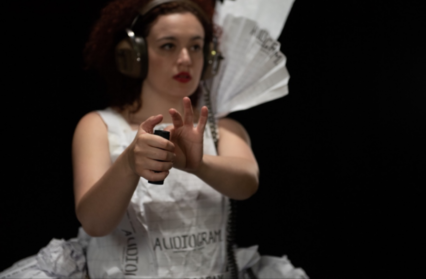Marine Furet reviews a performance film, Not Sorry, from Taking Flight Theatre and Artes Mundi featuring artist Stephanie Back reflecting on her experience of becoming deaf at age 15.
An interesting development in marketing produced by organisations is their ability to deliver hybrid pieces – not quite advertising, not quite art, these works provoke an aesthetic response at the same time as asking the viewer for an ethical response. Watching Not Sorry, Stephanie Back’s performance video produced as part of the Artes Mundi exhibition, it can sometimes be hard to tell the artistic impetus apart from other frames of reading.
Not Sorry was intended as a response to the recent Artes Mundi exhibition and particularly the work the soft afternoon air as you hold us all in a single death (to breathe full and free: a declaration, a re-visioning, a correction) (2020), by Firelei Báez. This alone would be a seductive brief to whoever has been lucky enough to witness Báez’s enchanting paintings, full of chimeric images, vivid colours, and textures as they stood, monumental, in the National Museum of Wales. It is also an autobiographical piece, alluding to the experience of its solo performer and creator, Stephanie Back, who became deaf at age 15. Lastly, it also harks back to the Second International Congress on Education of the Deaf held in Milan, which put forth a ban on sign language, holding lip reading as the only authorised form of communication for deaf people.
The entire piece, introduction and all, lasts all of 4 minutes and 42 seconds and as its viewer, it was at times hard to decide whether my experience was derived from the work itself or from the information I was expected to absorb prior to experiencing it.
Stephanie Back is, clearly, undeniably, talented. Her paper dress made of Audiograms, medical documents used to assess deafness, holds the keys to understanding one of the main underlying issues dealt with in this performance work. The audiogram, to cite Taking Flight’s website, is part and parcel of a paradigm the video seeks to deconstruct: ‘the Medical Model of Deafness. When using this model, Deafness is seen as an impairment to be cured.’ The dress embodies the process through which language describes, produces, and enforces norms, of which the deaf subject of the video – Stephanie at 15 – frees herself, ending the performance in a lusciously red slip-on dress, reclining amid the torn debris of her paper corset and skirt.
I was unaware of the existence of the conference prior to watching this video and, as a non-deaf, able-bodied woman, very aware that mine and Back’s experiences only intersect partially. The video’s linear model of storytelling is, in this way, very effective. When reading about the conference’s ban on sign language and imposition of lip reading, I am reminded of how, early on in the stages of making room in our daily lives for the strange constraints of Covid-19, we only started experimenting with masks that would reveal the mouth of their wearer quite late into the progress of the pandemic. Or of how one of my friends, an academic working on the politics and history of disability and facial normativity, recounts the lack of systematic accessibility policies in academic conferences. This is art that speaks, but about more than itself, and which is in a way already spoken for – in this way, is it successful, or is it a piece of pedagogy?
The thing is, the dress is also really pretty. It is as impractical as it is baroque and poetic. It reminded the author of this review of the dress worn by another woman held down by punitive medical discourses: Ellie, the heroine of Last Night in Soho, who sports her own beautiful papery creation at the beginning of the film – showing how, once more, fashion liberates as much as it subjugates.
Therefore, is the dress:
1) An allegory for the Victorian era?
2) A remainder of the performer’s adolescence, out of which she victoriously emerges, a beautiful woman with autonomous desires?
3) An intertextual reference to Firelei Báez’s work?
All those things can hold true. But it remains difficult to abstract the undeniable beauty of Back’s work from the very literal interpretive frame created for it by the ways in which our experiences of art are regimented when we meet them in the form of ‘engagement’ or ‘outreach’ – a tricky consequence of digital curation. These frames, paradoxically, make it more difficult for her art ‘to breathe full and free’, even as this limited insight into her art certainly makes me want to seek out more of Stephanie Back’s work. I am hesitant to take this review much further, as it would feel pretentious to write a text longer to read than the video it is intended to describe.
At the end of Not Sorry, the performer takes off her hearing aids while staring at her audience. This scene only lasts a short moment before the video comes to an end and seems to suggest that there is relief, joy, and sensuality in communication that does not only use verbal language as its medium. I was honoured to be the witness of this joy if not its primary recipient.
More details about Not Sorry are available here.
Marine Furet is a regular contributor to Wales Arts Review. This review reflects the opinions of the reviewer and not those of her employer.












